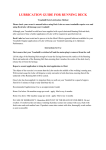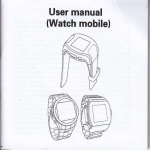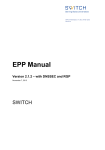Download Wiley Website Design and Development: 100 Questions to Ask Before Building a Website
Transcript
Chapter 1 MA TE RI AL Domain Names CO PY RI GH TE D In this chapter: Q 1. Have you thought of a good domain name for your website? Q 2. Do you need multiple domain names? Q 3. How much should you pay for a domain? Q 4. Do you know what makes a good domain registrar? Q 5. Who will register your domain and in whose name? 2 CHAPTER 1 DOMAIN NAMES Importance You cannot own a domain name. Domain registrants are given exclusive right to use a domain name for a certain period. This right is managed through regulatory agencies, such as the Internet Corporation for Assigned Names and Numbers (ICANN), the international agency that oversees generic (noncountry) domain names such as .com or .org, for periods of up to 10 years. You’ll hear of people selling their domain name, but what they’re really doing is transferring their right to use the domain for a fee. On Video Watch how to use an online domain search tool to brainstorm alternative versions of a domain name. There’s a lot to consider when choosing a domain name, but don’t take too long deciding. People have checked a domain’s availability in the evening only to find that it’s been taken by morning. 1. Have You Thought of a Good Domain Name for Your Website? Choosing a domain name is a key step in developing your website. Aside from being part of your branding, a domain name is one of the most common ways people will fi nd you on the Internet. That’s why a domain name needs to be memorable—by matching or relating to an existing name or by simply being catchy and unique. If You Have an Existing Offline Name If you already have an established name, you’ll want your domain name to be the same (or very close to it). If your company name is Healthwise Fitness Equipment, the top of your list will be healthwise fitnessequipment.com. Even if you’re commonly known as Healthwise Fitness, it would be better to have the word equipment in the domain because it will help the search engines distinguish you from fitness clubs or other businesses that use the name Healthwise Fitness. In case you can’t get the full name you want, have some variations prepared. For Healthwise Fitness Equipment, healthwiseequipment.com would be a good alternative. It retains the key part of your brand name as well as the search engine-friendly term equipment. The word health should be enough to keep you from being confused with a construction equipment company. Another alternative is to place dashes between each word: healthwisefitness-equipment.com. Keep in mind, however, that communicating those dashes can be tricky, and people will often forget to put them in. Other alternatives include short forms or acronyms—hfe.com—or if your business is confi ned to a region or a country, fi nd a domain name using your country’s extension, such as healthwiseequipment.us. Quite often a name that’s taken for .com will be available for a particular country. Some people say it’s better to keep your domain name as short as possible. Aside from the fact that many shorter names have already been snapped up, the length of the domain is not as important as its 1 . HAV E YO U T H O U G H T O F A G O O D D O MAI N NAM E FO R YO U R W E B S I T E ? memorability. If your company name is four words long, it will be easy to remember a domain name that matches those four words exactly. You can also help visitors remember a longer name by capitalizing words in print (HealthWiseFitnessEquipment.com) or using different colors for the parts of the name. If You Don’t Have an Offline Name For some businesses, deciding on a company name is one and the same with choosing a domain name. In most situations it’s best to fi nd a name that describes what you do. If your business is fitness equipment, try to get those terms in the domain name. It’s also possible to choose an unrelated but catchy or distinctive name. Take the thousands of social media startup companies on the Internet, for example, with names such as Squidoo, Ning, and Reddit. They’re trying to follow in the footsteps of online giants such as Amazon and Google, which have shown that an unusual domain name can be turned into a household word (with a lot of hard work and heavy marketing) Registering vs. Owning You often see domains written as www .mydomain.com, but the www is not actually part of the domain name. Increasingly you’ll see URL’s without the www but check with your host to see if your account is configured to accept either version. If it’s not and you leave off the www, your site won’t come up. Before fi nishing your list, you need to consider whether it would be good to have multiple domain names for your website—the topic of the next question. R Related Questions Q 3 2. Do you need multiple domain names? Page 4 Q 3. How much should you pay for a domain? Page 6 Action Item Q Draw up a list of as many good primary domain names as you can think of and rank them in order of desirability. You want to be sure to have plenty of alternatives if the ones you really want aren’t available. 4 CHAPTER 1 DOMAIN NAMES Importance You need to make sure that you correctly point additional domain names at your website. There can be negative consequences when dealing with search engines unless you do it right, which involves creating what’s called a 301 redirect. What this redirect tells search engines is that the website has permanently moved from one domain name to another. For detailed instructions try the search redirect phrase multiple domains 301. The part of the domain that comes after the very last dot (mydomain. com, mydomain.co.uk) is called the root or top level domain (TLD) extension. There are two common types: generic (gTLDs) such as .com, .org, and .biz; and country-code (ccTLDs) such as .uk, .ca, .au, .tv, and .co. 2. Do You Need Multiple Domain Names? Every website should have only one domain name by which it’s known, but there are all sorts of reasons to have additional domain names pointing to that site. Here are a few: Q Common misspellings—Suppose that your name is Healthwize; it would make sense to get an additional domain name with the spelling Healthwise because most people will enter it that way out of habit. Q Common variations—If you use a number in your primary domain (health2you), you should register an additional domain name with the literal spelling (healthtoyou). Q Doing business in multiple countries—A British company might have a domain name with the country top level domain .uk, but also have the domain name with .com. Keep in mind that most country domain regulators require a legal presence to register their domains. Q Block competing domains—Someone else might register the same domain with a different extension. You can prevent this by registering the .com, .net, and .org versions of your domain name, for example. Q Special promotional domain names —Suppose that you develop a fitness calculator on your Healthwise fitness website. It might be worth registering a domain such as takethefitnesschallenge .com and point it at that page on your site. Although most new domain names are not expensive, having a lot of domain names can add up, so you’ll need to weigh how important some of these variations are: how likely misspellings might be, how much competition there is, and whether people in a certain country care if they’re going to a domain with their country’s extension. 2 . D O YO U N E E D M U LT I P L E D O M A I N N A M E S ? As more top-level domain (TLD) extensions are added or country codes are opened to general use, there can be a lot of hype about the need to register your domain name with a particular extension to prevent competitors from snapping it up. Sometimes, that’s all it is—hype. But if a TLD extension does take off and come close to .com in popularity, you’d hate to miss out. The best bet is to keep an eye out for which TLD extensions are actually being used (how many .info domains you see, for example, after being available for several years now). Or if the price isn’t much more than a regular domain, it might be worth registering on a yearby-year basis to see where the extension goes. Related Questions R Q 1. Have you thought of a good domain name for your website? Page 2 Q 3. How much should you pay for a domain? Page 6 Action Item Q The most important type of additional domain name is the kind that visitors might easily mistype. So brainstorm some possible ways they can get it wrong. You can also do some testing by telling friends the proper domain name over the phone and asking them to write it out. 5 6 CHAPTER 1 Importance DOMAIN NAMES 3. How Much Should You Pay for a Domain? The price of a domain name is determined by two variables: the base price set by the agencies that control the various domain name extensions (.com, .us, .tv, and so on) and the markup charged by domain name registrars. That’s why you see such a variation in the prices charged by a single registrar for different domain extensions, as shown in Figure 1-1. FIGURE 1-1 On top of that, different registrars might offer radically different prices for the same domain extension by creating special offers; for instance, if you transfer over from another registrar or host your website through the registrar. Figure 1-2 shows different prices for a .com domain. FIGURE 1-2 3 . H O W M U C H S H O U L D YO U PAY FO R A D O MAI N ? You can also get an existing domain name by agreeing to pay the current registrant to transfer the registration to you. Many registrars offer domain name brokering services to facilitate these kinds of transactions, or some will run domain name auctions. The cost of registering a domain name this way is completely a matter of what you’re willing to pay the current registrant—it can be a couple of hundred dollars or a couple of thousand (or more). Figure 1-3 shows an example of a domains-for-sale page. 7 Sometimes you’ll see offers of a free domain, but remember that you’re paying for the domain somehow—usually by committing to a hosting contract for a period of time. Always read the fine print to understand the terms. For example, the domain might be free for only one year of registration, or you have to pay a high yearly rate for the domain name if you stop hosting with the registrar. The same can be true even for low-priced domains, so check to see what’s involved with any special deal. FIGURE 1-3 These are some of the reasons why it’s impossible to say what you should pay for any particular domain name, but here are a couple of rules of thumb for you to follow: Rule of Thumb Do not pay more than $12 per year for a new .com d domain (subject to fee changes from ICANN, the governing body). You can get .com names for less, but usually because you have to buy some other product or buy in bulk or transfer from another registrar, and so on. The point is, you don’t have pay more than $12 to get a .com with no strings attached from good quality registrars. Rule of Thumb as .tv, .co, .pro. Expect to pay more for specialty TLDs such On Video Watch the video on DVD showing an example of a domain registration scam letter and what it says in the fine print. 8 CHAPTER 1 DOMAIN NAMES A popular scam is when a domain registrar sends out a notice saying that your domain is expiring soon, so you should make sure that it’s safe by renewing now. Except that when you sign the form, you’re actually agreeing to transfer the domain from your existing registrar to this other company, and usually at crazy high rates (upward of $70 per year). Do not respond to these notices! Instead, use them as a reminder to log in to your true registrar and renew your domain at your regular rate. Some top-level domains such as .tv are actually country codes which have been licensed by the country to be sold to anyone in the world. You’re paying for the privilege of having this exclusive extension. In the case of other extensions, such as .pro, you’re paying for an accreditation process among other things. Some specialty domains such as .me have come down considerably in price after initial sales were slow, so sometimes it can pay to wait. Many domain extensions allow you to register a name for up to 10 years, whereas the minimum registration period is generally 1 year, but can sometimes be 2 years. Although registering for several years in advance eliminates the worry of missing a renewal, make sure that you don’t forget about your domain. In particular, it’s easy for your contact e-mail to have changed in a few years, so you end up not gett ing the renewal notice. As long as you keep your information up to date, lengthy registration times can be helpful. If you’ve registered a domain for a fairly new extension, it might be worth doing a yearly registration. The price for those domains can well go down over time (the .com names were $35 per year not that long ago), and it would be a shame to lock it in at the higher price. The fi nal point to keep in mind about domain pricing is that domain registrars have nothing to offer except price and service. Having an amazing price with poor service is no deal at all. But what counts as good service from a registrar? That’s the topic of the next question. Related Question R Q 2. Do you need multiple domain names? Page 4 Action Item Q Survey the sites of several registrars to get a sense of what they’re all charging for a particular domain extension. 4 . D O YO U KN O W W H AT MAKE S A G O O D D O MAI N R EG I S T R A R ? 4. Do You Know What Makes a Good Domain Registrar? There really isn’t much for a domain registrar to do except record who registered which domain name, so the only way to tell registrars apart is by the other services they offer. These services break down into two broad categories: Q Domain management—How easy is it for you to manage your domains, update information, organize multiple domains, and so on? Q Add-on functions—Does the registrar offer services such as auto renewal or free e-mail accounts? If you have only one domain, the quality of a registrar’s domain management interface might not be all that important. But if you have more than one, you’ll appreciate being able to easily tell the status of all your domains, organize them into groups, sort them in various ways, quickly manage where the domains are pointing, and so on. Figure 1-4 shows an example of a good domain manager layout. The other important part of a domain management system is the help function. You deal with domain names once and then maybe not again for another year or more. Without a good help system, it can be difficult to remember what you should be doing. Contextual popup help screens are good, but video tutorials are even better. FIGURE 1-4 9 Importance Registrars vs. Hosts It’s easy to think these two are one and the same because so many registrars offer web hosting and so many web hosting providers offer domain names. But there is absolutely no requirement that you have your domain names registered through the company that hosts your website, or vice versa. Registering domains and hosting websites are two distinct functions. If you discover a domain registrar with better pricing or services, you can transfer your domain to that other registrar at any time. Your existing registrar should not charge any fee for this, but the new registrar will charge you for an additional year of registration (which you would have spent anyway). 10 CHAPTER 1 DOMAIN NAMES On Video For a detailed view of a domain management interface, I’ve created a short tour on the DVD. Use one domain regis-trar for all your domains. Ending up with two or three or more registrars can be a nightmare of paperwork, and you can even end up missing notices for domains that need to be renewed. When you’re checking out domain registrars, look for a demo of the domain management interface on their websites: a live demo that you can try out or at the very least a video demo. If there’s nothing there, you can always call their sales department and request a tour. Remember, you can get good quality management tools and very low domain prices, so don’t just settle for low prices. It’s also useful for domain registrars to offer add-on functions that make your life easier. Here’s a checklist in order of what I think is most important: Q Frequent renewal notices—Receive at least 60, 30, 15, and 7 days before a domain expires (e-mail gets lost, or you’re away, and so on). Q Auto renewal—You can turn this on if you don’t want to worry about renewal notices at all. Just make sure your credit card is up to date. Q Auto lock—This requires a special code if you want to transfer to another registrar, but it also means that someone can’t easily transfer the domain without your authorization. Q Free e-mail—If you don’t have a website yet, you can still have e-mail service using the domain name. Q 301 redirects—If you want to use the domain name to point to an existing website, this is the proper way to do it. R Related Question Q 3. How much should you pay for a domain? Page 6 Action Item Q To get you started on finding registrars, search for the phrase top 10 domain registrars. 5 . W H O W I L L R EG I S T E R YO U R D O M AI N A N D I N W H O S E N A M E ? 5. Who Will Register Your Domain and in Whose Name? 11 Importance Although registering a domain name is straightforward, some people are not comfortable doing it themselves or they’re too busy, so it’s not uncommon for a web designer or a company to register a domain on behalf of their client. If that’s how you’re having your domain name registered, there are several steps you’ll want to take to make sure that the domain remains under your control. At the very least, you should be listed as the registrant: Use your mailing information, your e-mail address, and so on. The registrant is the one who controls the domain name. There are three other contacts for a domain name: administrative, technical, and billing. Usually all four contacts are the same, but it can be useful to have the person or company helping you listed as the technical contact. That way they have authority to talk to the registrar if there are technical issues to be resolved. The key is that you be listed as the registrant. Of all the information listed for you as registrant, the most important is your e-mail address. It’s used for a number of crucial tasks: Q Notifying you of the domain’s expiration date Q Sending approval requests should you want to transfer to another domain registrar Q Sending password information should you ever lose your password Once the domain name has been configured so that it’s pointing to your server and your website is functional, you should change the password for the domain manager. You can always supply the designer or company with this new information should they later need to help you with the domain name. What you don’t want is to discover a year later that some former employee still has access to your domain and goes in and changes the registrant e-mail and password, thereby taking control of the domain. If you’ve had a domain name registered, but you don’t have any of the login information for the domain, do what’s called a whois search at On Video Watch how you can register a domain name yourself. It’s a good idea for your contact e-mail not to be the same as your domain name. If your domain name expired, any communication from the domain registrar would no longer work. Be careful about using an e-mail address from your ISP—if you change ISPs or move, be sure to update your contact e-mail address for your domain name. 12 CHAPTER 1 DOMAIN NAMES Your domain managel ment login is completely separate from your hosting control panel login. Remember that your domain name is not the same as your website— the domain tells the world which server has your website files. Make sure the login data for your domain and your hosting control panel are different. a site like domaintools.com. You can fi nd out the registrar and whether you’re listed as the domain registrant. If your e-mail is listed properly, you can use the registrar’s lost password function to gain access. If you’re not listed as the registrant, contact the company or person who registered on your behalf and get the login information from them; then go in and change the registrant information to your own. If the domain is one of many in the other party’s domain manager, simply sign up with the same registrar and initiate a domain transfer (or if you already have a domain manager, start the transfer). If you’re not listed as the registrant and the existing registrant won’t give you the login information or do a transfer, start by contacting the registrar with proof that you hired that company or person to register the domain name on your behalf. After that there are varying types of dispute resolution depending on the agency overseeing the TLD. Related Questions R Q 4. Do you know what makes a good domain registrar? Page 9 Q 96. Will you routinely check your contact information? Page 282 Q 98. Will your site administration be securely accessed? Page 288 Action Items Q If you don’t have a domain name yet, registration is very easy to do yourself. You can get someone to help you later with correctly pointing the domain at the server, and then change the password when they’re done. Q If someone else is going to register your domain for you, clarify in whose name it’s being registered. Make sure it’s yours. Also, make sure they’re paying a good price. Q If you already have a domain name registered, but didn’t do it yourself, check who is listed as the registrant.























